Author: GoPlus
Introduction
With the rapid development of Web3.0, more and more users are entering this field and investing. Among the on-chain investment field, meme coins have become the most popular and attractive investment object for users. Meme coins have the characteristics of fast issuance, high volatility, and anonymity of issuers. However, a large number of scam groups have taken advantage of users' enthusiasm for meme coins, disguised as meme coins, and carried out a large number of on-chain fraudulent activities targeting users. These criminals use the characteristics of smart contracts to design various risky tokens, deceiving users to invest and illegally profit by triggering code backdoors and other means. These risky tokens usually have the following characteristics: the contract creator has the permission for unlimited issuance, users can only buy and cannot sell, malicious black and white list settings, and the trading tax can be maliciously tampered with, etc. Once users purchase these tokens, it is highly likely to cause financial losses that cannot be recovered. In response to the increasingly serious fraud risks, identifying and warning about risky tokens has become particularly important. This article will analyze the situation of risky tokens on five relatively popular Ethereum Layer 2 networks (Base, Arbitrum, Optimism, Blast, Mantle) based on the GoPlus Security API and real on-chain data over the past three quarters, in order to provide reference and warnings to the general users.
Method Description
Data Source
The GoPlus Security API is an open and license-free Web3.0 security data API service provided by the GoPlus team for developers and end users in the Web3.0 field. This service provides professional developers in the technical field with the ability to protect their users and meet the security needs of C-end users.
- The transaction data on various chains is mainly counted and queried through DUNE
Analysis Method
Based on the GoPlus Security API, we have scanned a total of 564,180 potential risky tokens on 5 top L2 chains (called by users through products integrated with the GoPlus Security API).
We conducted data analysis and visualization of the above suspected risky tokens based on DUNE, and formed an open-source dashboard that displays three data indicators:
- the number of unique traders involved in suspected risky tokens
- the transaction amount involved in suspected risky tokens
- all suspected risky tokens contract addresses
The sample period of this article is the past three quarters, specifically from August 1, 2023, to May 24, 2024. Since the Blast chain was launched in March 2024, its sample period started from March 2024, but some ERC20 tokens on its chain were issued in February 2024.
Definition of Risky Tokens
The definition of risky tokens in this article mainly comes from Token Risk Classification (TRC). The detailed definitions of each of the following conditions can be found in TRC. Specifically, in this article, any smart contract that meets any of the following conditions is considered a potential risky token.
- Honeypot (TRC-001): The token has a "honeypot" mechanism, allowing users to buy but not sell
- OwnershipRetrieval (TRC-003): Token ownership may be maliciously retrieved
- AntiWhale (TRC-014): The token contract can restrict transactions of large holders, and specific users may not be able to cash out freely.
- TransferPausable (TRC-011): Token transfers can be paused, and user funds may be maliciously frozen
- SlippageModification (TRC-010): The token contract can arbitrarily modify slippage, and users may suffer unpredictable losses
- BlacklistFunction (TRC-008): The token contract can set a blacklist, and specific users may not be able to transfer and trade freely
- WhitelistFunction (TRC-013): The token contract can set a whitelist, and specific users may not be able to transfer and trade freely
- TradingCooldown (TRC-016): The token contract can set a trading cooldown period, and users may not be able to trade in a timely manner
- SelfDestruction (TRC-006): The token contract can self-destruct, and the tokens held by users may suddenly disappear.
- ExternalCall (TRC-007): The token contract can call external contracts, posing a risk of being maliciously exploited
- PersonalSlippageModification (TRC-012): Specific users' slippage can be modified, and the target users may suffer targeted losses
- AntiWhaleModification (TRC-015): The transaction restrictions of large holders can be modified, further harming the interests of specific users
- BalanceManipulation (TRC-004): Token balances can be arbitrarily modified, and the quantity of tokens held by users may suddenly change
- HiddenOwnership (TRC-005): The identity of the token owner is hidden, making it difficult to trace the responsible party
- FullSaleRestriction (TRC-009): The token contract can completely restrict sales, and holders may not be able to cash out in a timely manner.
- FullBuyRestriction: The token contract can completely restrict purchases, and holders may not be able to cash out in a timely manner.
- NotOpenSource: The token contract code is not open source
Base
Number of New Tokens and New Suspected Risky Tokens on Base Chain

Over the past three quarters, a total of 573,484 ERC20 tokens were newly added on the Base chain, of which 381,790 newly added suspected risky ERC20 tokens were scanned, accounting for approximately 66.6%! That is, over the past three quarters, more than half of the newly issued ERC20 tokens on the Base chain are suspected risky tokens.
The trend of the number of newly added ERC20 tokens on the Base chain shows a decrease followed by a significant increase, especially since March 2024, the number of newly added ERC20 tokens on the Base chain has significantly increased. In April 2024, the number of newly added ERC20 tokens on the Base chain was the highest, reaching 240,000.
The number of addresses involved in suspected risky ERC20 tokens on the Base chain is highly positively correlated with the number of newly added ERC20 tokens, and the two trends are similar.
Number of User Addresses Involved in Suspected Risky Tokens on Base Chain
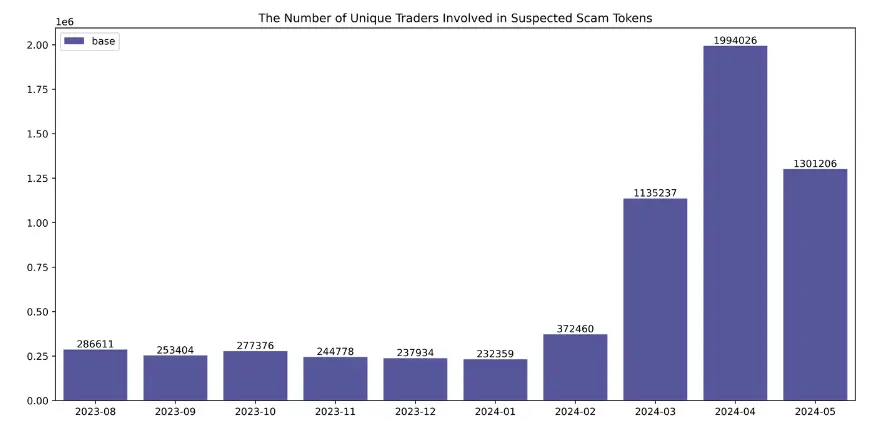
Before March 2024, the number of addresses involved in suspected risky tokens on the Base chain remained relatively stable, at around 230,000 to 300,000. However, overall, the number of addresses involved in suspected risky tokens on the Base chain showed an upward trend, slowly increasing from 287,000 in August 2023 to 372,000 in February 2024. Subsequently, there was a sharp increase, reaching 1.135 million in March 2024 and 1.994 million in April 2024. Although there was a slight decrease to 1.301 million in May 2024, it was still far higher than the level in the same period of 2023, and May 2024 has not yet ended. It is evident that as time passes, the risk of fraud that users on the Base chain face continues to intensify.
Arbitrum
Number of New Tokens and New Suspected Risky Tokens on Arbitrum Chain
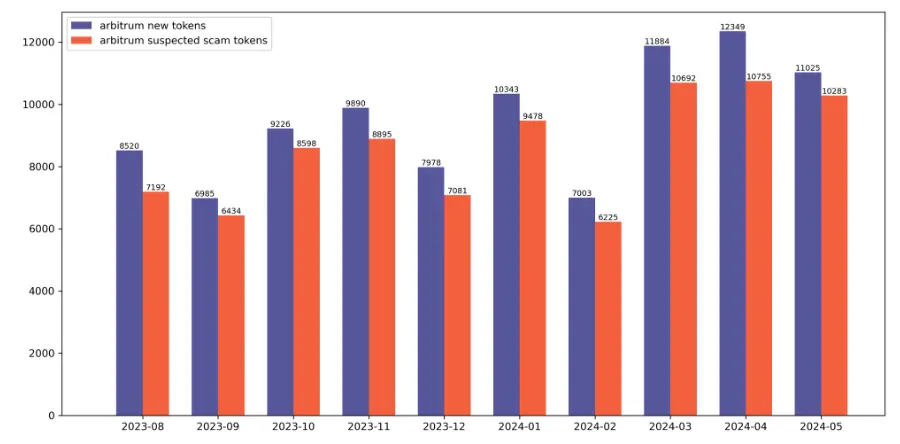
Over the past three quarters, a total of 95,203 ERC20 tokens were newly added on the Arbitrum chain, of which 85,633 newly added suspected risky ERC20 tokens were scanned, accounting for approximately 89.9%!
The number of newly added ERC20 tokens on the Arbitrum chain showed a relatively stable and slight upward trend. It increased from 8,520 in August 2023 to 12,349 in April 2024.
Similar to the Base chain, the number of newly added suspected risky ERC20 tokens on the Arbitrum chain is highly positively correlated with the number of newly added ERC20 tokens, showing a consistent trend.
Number of User Addresses Involved in Suspected Risky Tokens on Arbitrum Chain
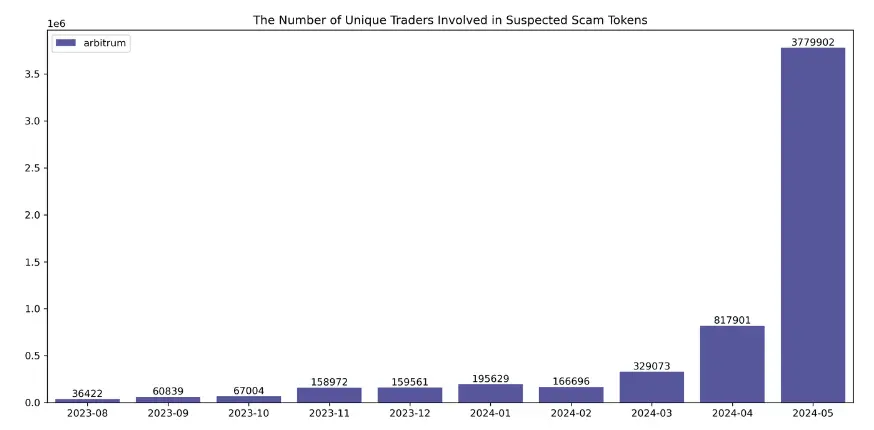
The number of addresses involved in suspected risky tokens on the Arbitrum chain showed a significant upward trend, especially from March 2024 to May 2024, during which the number increased significantly. The number of addresses involved in suspected risky tokens on the Arbitrum chain increased from 36,000 in August 2023 to 3.78 million in May 2024, a growth of approximately 105 times!
In May 2024, the number of addresses involved in suspected risky tokens on the Arbitrum chain reached 3.78 million, posing a serious threat to users' asset security.
Optimism
Number of New Tokens and New Suspected Risky Tokens on Optimism Chain
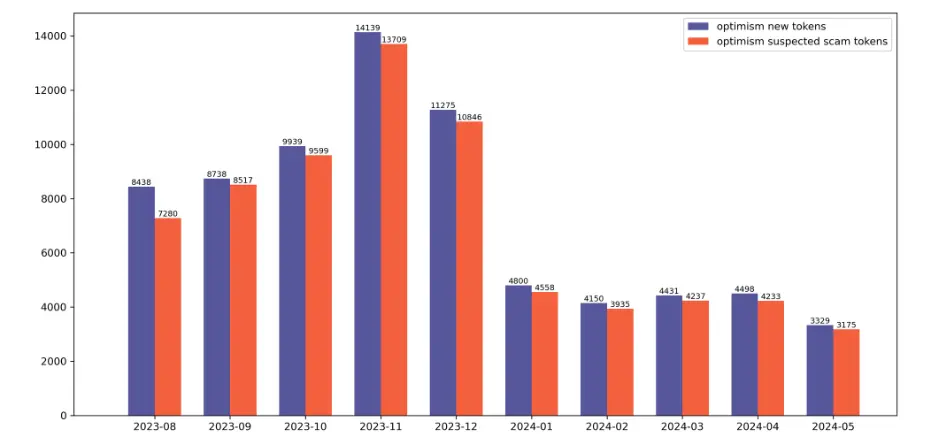
Over the past three quarters, a total of 73,737 ERC20 tokens were newly added on the Optimism chain, of which 70,089 newly added suspected risky ERC20 tokens were scanned, accounting for approximately 95%! That is, approximately 95% of the newly added ERC20 tokens on the Optimism chain over the past three quarters are suspected risky tokens!
The number of newly added ERC20 tokens on the Optimism chain is also highly positively correlated with the number of newly added suspected risky ERC20 tokens.
The trend in the number of newly added ERC20 tokens showed an initial increase followed by a decrease. During the cryptocurrency bull market from March to May 2024, the number of newly added ERC20 tokens on the previously mentioned chains significantly increased, while the number of newly added ERC20 tokens on the Optimism chain was relatively low, averaging about 4,500 ERC20 tokens per month.
Number of User Addresses Involved in Suspected Risky Tokens on Optimism Chain
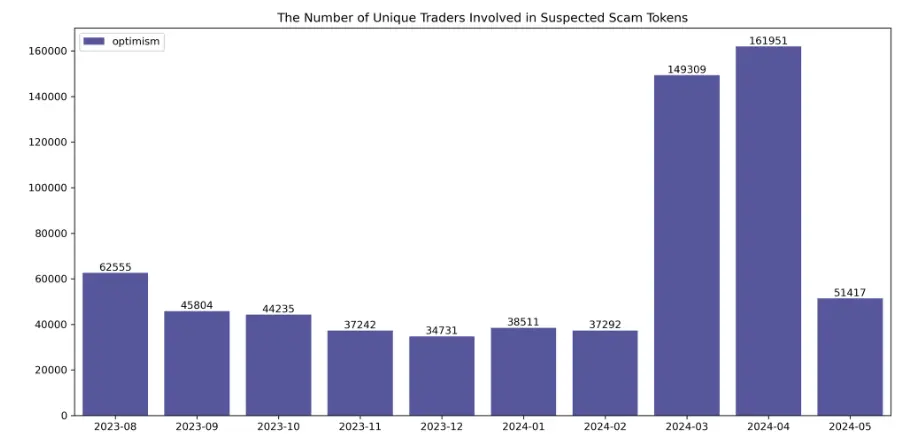
The number of addresses involved in suspected risky tokens on the Optimism chain is significantly lower than the other two chains mentioned above. Before March 2024, this number fluctuated relatively little. From March to May 2024, the number of addresses involved in suspected risky tokens on the Optimism chain increased significantly.
During this period, although the number of newly added suspected risky ERC20 tokens on the Optimism chain was relatively low, the number of addresses involved in suspected risky tokens increased significantly. This phenomenon may be due to a large number of users being affected by previously suspected risky tokens during the cryptocurrency bull market, or it may be because a small number of newly added suspected risky tokens during this period affected a large number of users.
Blast
Number of New Tokens and New Suspected Risky Tokens on Blast Chain
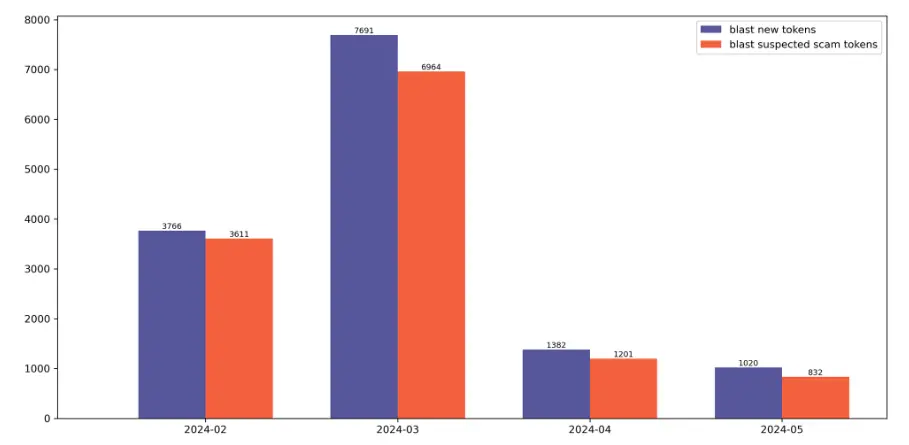
The Blast chain went live in March 2024, but there were transactions on the chain in February 2024, so the data is only available for February to May 2024.
Over the past three quarters, a total of 13,859 ERC20 tokens were newly added on the Blast chain, of which 12,608 newly added suspected risky ERC20 tokens were scanned, accounting for approximately 91%.
The number of newly added ERC20 tokens on the Blast chain showed a decreasing trend. After the mainnet launch of the Blast chain in March 2024, a large number of ERC20 tokens were quickly added, followed by a gradual decrease in the number of newly added tokens. Approximately 91% of the newly added ERC20 tokens were suspected risky tokens.
Number of User Addresses Involved in Suspected Risky Tokens on Blast Chain
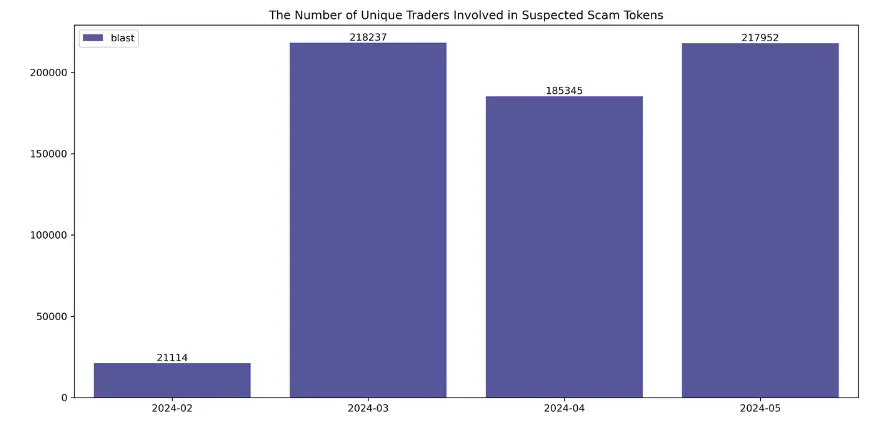
After the mainnet launch of the Blast chain in March 2024, user growth was rapid, and on-chain transactions were active. The data shows that in March 2024, the number of addresses involved in suspected fraudulent contracts on the Blast chain reached 642,000, close to the 663,000 on the Optimism chain, indicating that trading on suspected risky tokens on the Blast chain is very active. As of May, the number of addresses involved in suspected risky tokens reached 218,000, possibly reaching a historical high. As an emerging L2 chain, the issue of fraud on the Blast chain has begun to emerge and deserves high vigilance.
Mantle
Number of New Tokens and New Suspected Risky Tokens on Mantle Chain
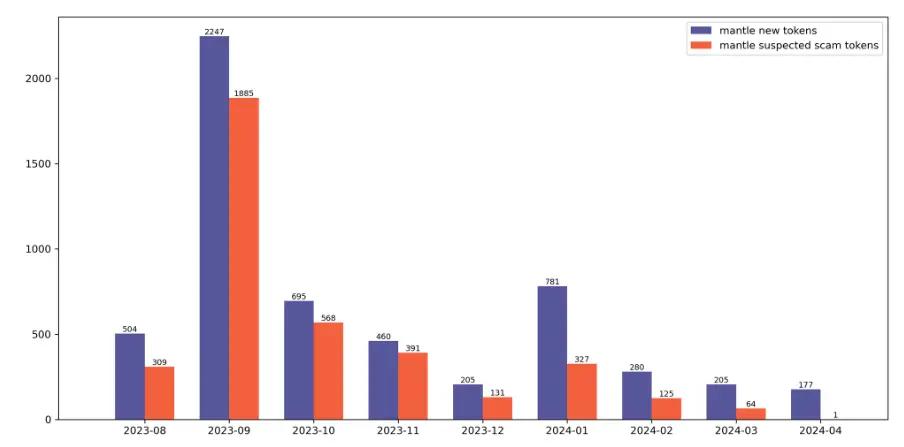
Over the past three quarters, a total of 5,645 ERC20 tokens were newly added on the Mantle chain, of which 3,801 newly added suspected risky ERC20 tokens were scanned, accounting for approximately 67.3%.
The proportion of newly added ERC20 tokens and newly added suspected risky ERC20 tokens on the Mantle chain showed a decreasing trend.
The number of newly added suspected risky tokens on the Mantle chain is the lowest among the five chains.
Number of User Addresses Involved in Suspected Risky Tokens on Mantle Chain
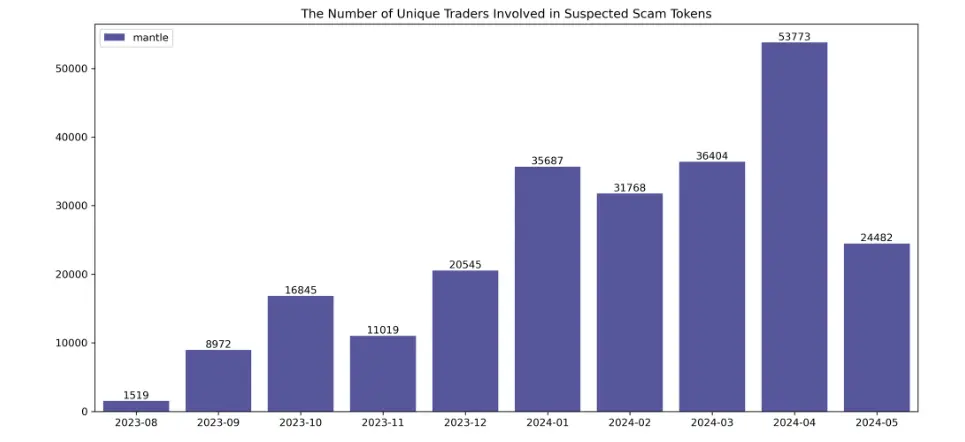
The number of addresses involved in suspected risky tokens on the Mantle chain is relatively low, even lower than the newly launched Blast chain. However, the data shows that this indicator showed an overall upward trend, increasing from about 1,519 to around 54,000, a growth of over 35 times. Therefore, the issue of fraud on the Mantle chain also deserves high vigilance.
Conclusion
Overall, the rapid increase in the number of addresses involved in suspected risky tokens on various Layer-2 Ethereum networks indicates a worsening investment environment for users. The data clearly shows that as these networks become more popular, the risk of encountering scams is increasing, especially in scams related to Meme tokens. This trend is evident across all analyzed networks. As the entire field continues to develop, we all need to remain vigilant and actively guard against these threats. GoPlus Network, as an open, permissionless, and user-driven Web3 modular user security layer, provides users with protection throughout the entire trading lifecycle. By utilizing a decentralized user security network and advanced AI-driven security solutions, it can provide in-depth risk analysis and intelligent, efficient security services for users. If users encounter any security issues, we will do our best to help resolve them.
免责声明:本文章仅代表作者个人观点,不代表本平台的立场和观点。本文章仅供信息分享,不构成对任何人的任何投资建议。用户与作者之间的任何争议,与本平台无关。如网页中刊载的文章或图片涉及侵权,请提供相关的权利证明和身份证明发送邮件到support@aicoin.com,本平台相关工作人员将会进行核查。




